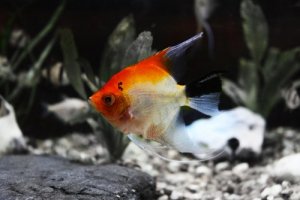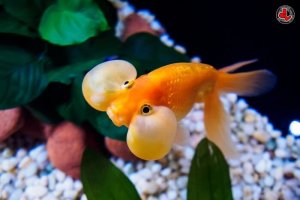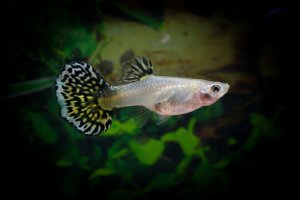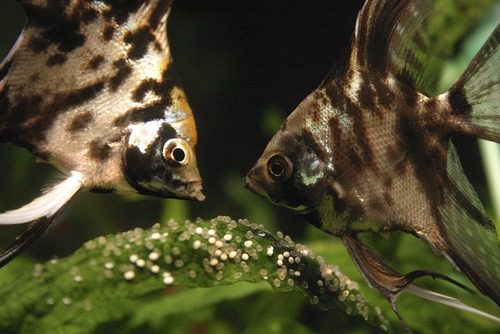
Angelfish are one of the most kept freshwater fish species from the cichlid family, and they are quite new to the aquarium hobby only being bred in captivity from the late 1920s. They have a unique shape and elegant appeal, as well as a few color variations that make them so appealing in the aquarium trade.
Generally easily bred, Angelfish are oviviparous (lay eggs), Unfortunately, they are volatile and temperamental creatures that may care for their eggs and fry, or prefer to eat them, especially when they are new parents.
However, let us get a bit further into the Angelfish species and their breeding habits, to fully understand the hatching time and process for their eggs.
Angelfish Species Review
Angelfish originate from the Amazon and Orinoco basins in South America and have round laterally compressed bodies, and elongated fins to allow them to hide among plants and roots easily. They are Freshwater fish; however, a marine version does exist. Angelfish have a lifespan of around 12 to 15 years, and adult sizes are usually around 6 inches (15 cm) in length and 8 inches (20 cm) in height. There are two major species, the P. Scalare and the P. Leopoldi which are the most common, and the P. Altum which is rarer.
Quick Care Tips For Angelfish
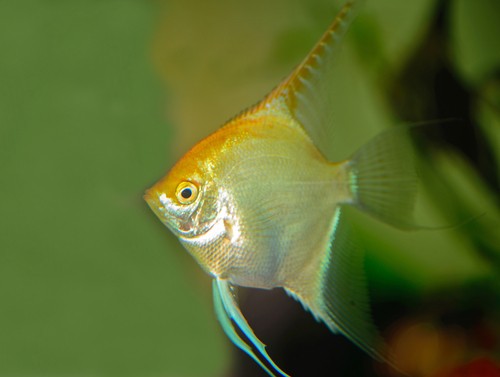
Most Angelfish species including the Black Angelfish are also known as ambush predators and may prey on smaller fish.
- Compatibility And Behaviour – Unfortunately, they are no “Angels”! Angelfish are known as ambush predators that prey on smaller fish, they are semi-aggressive and will easily turn on tank mates when hungry, or become quite territorial when paired. Similarly, fin nippers such as Tiger Barbs may nip at the fins of the slow-moving Angelfish. Some Tetra and Barb species are ideal to keep with Angelfish, alongside other peaceful larger species. As adults, they will select a mate and prefer to be in pairs that will become slightly territorial.
- Aquarium Preference – Angelfish requires at least a 30-gallon tank, with an additional 20 gallons per fish. They prefer warm water climates around 80 °F (27 °C), and soft acidic water with a pH between 6.5 and 7.0. Angelfish tend to forage at the bottom of the tank, thus a medium to fine gravel or sand is ideal. They similarly love a more serene and natural aquarium with plenty of hiding spaces, plants, and an open central area for swimming. Some ideal live plant options for them include;
Here are a few Plant Types that Black Angelfish are Particularly fond of:
- Anacharis
- Amazon Sword
- Java ferns
- Water Sprites
- Bolbitis
- Anubias
- Cryptocoryne
- Diet – Angelfish are mostly omnivores, though they mainly eat insect larvae and other smaller fish in the wild. They forage on the bottom and feed from the surface and mid-layers of the tank, requiring a meal around twice a day. A good diet will consist of quality flakes or pellets, meat-based foods that are freeze-dried, frozen or live, and blanched vegetables.
- Common Health Issues – Angelfish, even though they have a semi-aggressive nature are quite fragile in terms of disease and injury. They may suffer from most regular freshwater illnesses such as; ich, Fin Rot, Dropsy, and Physical damage from sharp décor or fin-nipping fish.
- Male And Female Differentiation – The most reliable method to determine the gender of an Angelfish is to look at the genital tubes just before the anal fin. The male will have a pointy and narrow tube, whereas the female will have a rounded cylindrical tube.
Other telltale signs are:
- Males will have upright dorsal fins, and females slightly backward-laying dorsal fins.
- Males have ventricles that are more erect while females hold them closer to their body.
- Females have a smooth sloped head, and males have a distinct bump on the head.
Breeding Angelfish
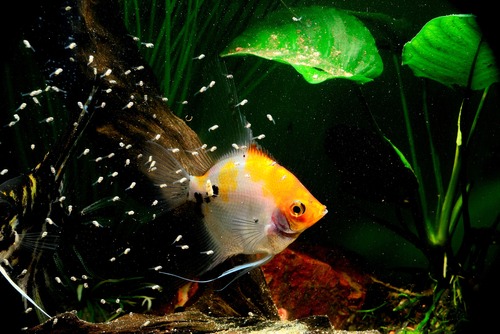
When around six months old, Angelfish will choose their partner, and they partner for life, even though a partner dies, they may never choose another. In terms of relationships, they are perfect, protecting and nurturing each other, and their young. As a warning many times new parents Angelfish may eat their eggs and fry, though as they become more seasoned in breeding, this will stop.
An Angelfish pair will find a safe spot for spawning, and usually a broadleaf or slanted surface to lay their eggs, The male fertilizes the eggs and they keep on spawning until around 100 or more eggs are laid. The parents take turns circulating water around the eggs for a few days until the eggs hatch, while the fry remain on the same surface, surviving on their yolk sacs still attached to them.
When the fry become free swimming, they can be fed meat-based foods such as brine shrimp. Parent Angelfish will protect their young and eggs, which also helps to delay another cycle of reproduction, so it is your choice whether to keep them in a communal tank, or a separate breeding tank. Just be careful of other species’ tank mates that may eat the eggs or fry.
Should You Have A Breeding Tank?
There is quite some noticeable concern about whether a separate breeding tank should be created for breeding Angelfish or not, ideally, you would not require a separate breeding tank. However, if you have one of the following concerns, it would be better to have a separate tank for the eggs, or your Angelfish and their eggs.
- If you have a communal tank with other fish species that will most likely eat the eggs or the new hatchlings, it is better to consider a separate tank for breeding or the eggs. Even with dense vegetation and plenty of hiding spaces, your fry, or eggs may still experience a lower survival rate. Common species that will eat fry are:
-
-
- Bettas
- Gouramis
- Swordfish
- Platies
- Cichlids
-
- Should you be breeding as a hobby or profession, you may want to remove the eggs to allow the male and female to spawn again after two weeks rather than caring for the eggs and fry.
- With new Angelfish parents, they are quite likely to eat their eggs or fry, being inexperienced, thus the first time around if you notice this behavior you should rather separate the eggs.
Because it can be quite difficult to remove eggs from a communal tank, as well as harmful to the eggs, it is advised to set up a spawning tank, and to remove the parents rather than doing it the other way around.
Setting Up Your Breeding Tank
Firstly you will need a large 20-gallon tank for your breeding pair and an adult breeding pair of around 6 months old that have bonded with each other.
- Water conditions need to be clean and clear, a sponge filter that is cleaned regularly will not trap young fry. Temperatures of 78 to 85 degrees Fahrenheit (25 to 29 degrees Celsius) are ideal, with a pH between 6.5 and 7.5.
- Angelfish prefer a more dimmed environment with lush vegetation and many long-rooted plants which will also come in handy for fry to hide.
- You will need what is called a breeding substrate, anything from a slate, large leaf plant, or a terracotta pot or part of it for the female to deposit her eggs.
- Make sure to feed your pair plenty of protein at least three times a day to encourage spawning.
- When the eggs are laid and fertilized it is imperative to keep the water as clean as possible and to keep temperatures consistent to prevent fungus from infecting your eggs.
The parents can be returned to the communal tank if you are worried that they may eat the fry or eggs. However, this may encourage them to breed again in the next two weeks, and your fry in the breeding tank will still be quite small at this stage, though completely capable of hiding if needed.
How Often Do Angelfish Lay Eggs?
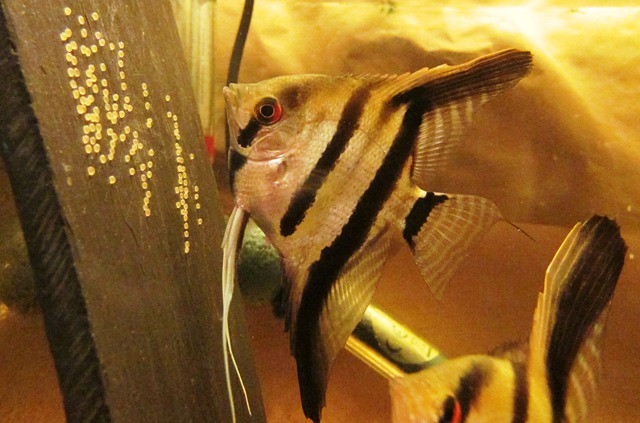
Now, to completely answer this question there are a few scenarios to consider:
- If the eggs are removed eggs to a proper set-up and well-circulated breeding tank, your Angelfish should lay eggs again in two weeks or less, if this is what you desire.
- If the Angelfish are allowed to guard their eggs and raise their fry, they will not lay eggs again until the babies have been removed or have become dependent. Of course, this is to say if, in the rare event, they do not decide to feast on the eggs or fry.
- Female Angelfish can lay eggs without a male around every week or two, though these eggs remain unfertilized, and will decay if not removed from the tank, or they may serve as a snack for other tank mates.
- Usually, Angelfish will retire laying eggs and breeding from around 3 years of age.
What Do Angelfish Eggs Look Like?
Angelfish can lay anything between 100 and over 100 eggs at a time. When it comes to the color of your Angelfishes’ eggs, is an excellent indicator of whether the eggs are fertilized and healthy.
Most Fertilized Angelfish Eggs will be a translucent color that can range in colors from yellowish, to amber or brown. Unfertilized eggs are white or cloudy in color.
It is important that your fertilized Angelfish eggs only have very subtle variations in colors such as translucent, amber, yellow, or brown, and nothing too bold, otherwise, there may be complications with the eggs.
- White/Opaque – The eggs are either unfertilized or have fungal growth on them.
- Darker Brown – There may be a bacterial infection.
- Green – Algae is growing inside or on the egg.
- Red-Brown – This may indicate blood spotting inside the egg because of damage or rough handling.
Unfortunately, eggs that are white or cloudy rarely have a chance of hatching and are usually unfertilized or have a fungal infection. Proper water circulation and parameters are essential for the health of Angelfish eggs.
Another factor is that Angelfish eggs may change color over time only, and there are a few reasons for this:
What Causes Angelfish Eggs To Change Colors?
- Fertility Issues – White or opaque-colored eggs are usually unfertilized, and your male Angelfish may have not done his job properly, or there may have been an interference or interruption during his deed.
- Fungus – Another reason your Angelfish eggs are turning white, especially if they have a fuzzy appearance, is a fungal infestation, in which case there are some steps you can follow to save the eggs and prevent fungus from spreading.
-
-
- Clean Your tank and replace 10% of the water every three days.
- Remove infected eggs and clear your filter for eggs or fungus that may have remained.
- Use a Chemical treatment such as methylene Blue, Hydrogen Peroxide, potassium permanganate, iodine, acriflavine, or rosemary extract.
- Maintain a clean tank with proper temperatures and pH levels to prevent fungus from returning.
-
- Poor Water Conditions – Angelfish need clean water with the right conditions, and water temperatures between 78 to 85 degrees Fahrenheit (25 to 29 degrees Celsius), with a pH of 7.0 being ideal. Nitrites and ammonia can cause a negative reaction to the hatching process and eggs.
- Harsh Water Flow – A strong current, or heavy water flow in your tank may be the reason that your eggs remain unfertilized because sperm is being washed off the eggs. You do need good filtration, though it would be advisable to place the breeding substrate (leaf or slate) in an opposite corner to the filter to reduce harsh currents.
- Handling – In some cases, you may need to move the eggs because your Angelfish may tend to eat them. In this case, handling can harm the eggs. Even, water conditions and fluctuations may cause harm to the eggs when moved, thus they must be acclimated properly.
How Long Do Angelfish Eggs Take To Hatch?
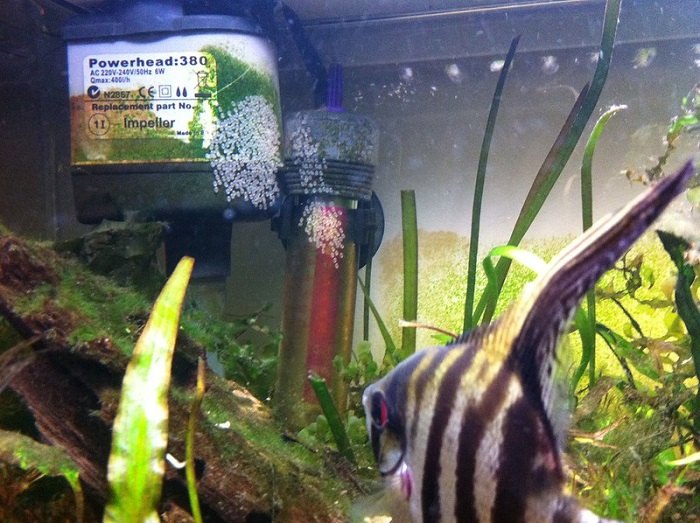
To answer the main question, information has been consulted from a scientific study to give you an idea of the incubation period of Angelfish Eggs.
According to findings, Angelfish given proper nutrition will spawn two to three times a month, there were 825 eggs of which 95.3% hatched within two to three days. The fry were free swimming within 2-4 days, after feeding on their yolk sac, and 75.55 survived. Much of the loss of fry and eggs originates as a result of fluctuations in water temperatures at night.
From further trusted sources it has been noted that eggs can take anything between 2 – 5 days at most, and much of the information as mentioned relies on water parameters and temperatures, which is why it is vital to keep eggs in the mid-temperatures of 78 to 85 degrees Fahrenheit (25 to 29 degrees Celsius).
In Conclusion
Angelfish are ideally easy to breed, they pair up for life and can make good parents, especially with their second or third brood. The color of Angelfish eggs is an important characteristic to keep you informed on the health of the eggs, and whether they are essentially fertilized.
You should be able to have healthy young fry in around 2 days or more, just beware of other tank companions, and parents, should they develop cannibalistic tendencies. A well-planted tank in turn will provide plenty of hiding spaces for young fry to stay safe and relaxed.


